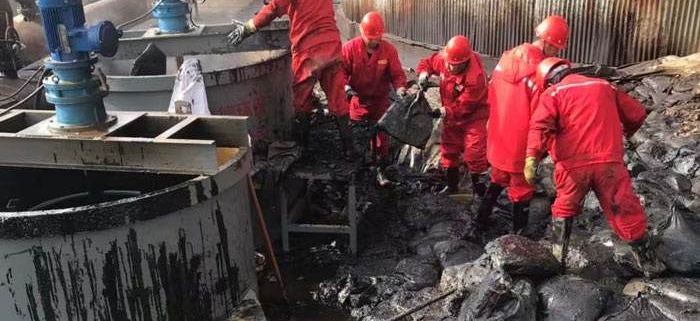Tank bottom sludge is mainly derived from oily sludge produced during oil production and gathering and transportation. Among them, the oily sludge produced during oil recovery is mainly produced by trial production, discharge, fracturing, acidification, pipeline perforation, and maintenance operations. Crude oil and oily sludge. The oily sludge of the gathering and transportation system is mainly the sludge, oil sands removed from sewage tanks, oil tanks and sedimentation tanks of transfer stations and joint stations. The solid content of this type of sludge is generally between 15% and 30%. It has the characteristics of large viscosity, strong cohesion, high temperature, low utilization rate of chemicals, complex ingredients, and slow natural sedimentation.
There are several methods to clean up, transfer and treat the bottom of the tank:
1. Draining the bottom oil: The bottom oil of the oil tank is pumped with an explosion-proof oil pump. After being filtered and screened by the stainless steel filter three times, the screened oil is transferred to other oil tanks for storage. After screening, the remaining oily pollutants (such as sediment, oily water, etc.) are confirmed to have no use value by the power plant, and then pumped to the tanker truck for transportation and environmental protection. If there is too much oil sludge at the bottom of the tank, which cannot be pumped safely, it can be cleaned by manual cleaning after it has reached the conditions of manual tank entry and collected in the waste oil recovery vehicle or the recovery container.
2. Tank cleaning: According to environmental protection requirements, tank cleaning should reduce the discharge of oily sewage as much as possible. After the oil impurities in the tank are cleaned up, clean it.
3. For oil tanks with severely corroded tank walls, when the oil and gas concentration drops below 20% of the lower explosion limit, it can be flushed with high-pressure water. Metal parts such as metal pipelines and water line nozzles introduced into the tanks should be electrically connected to the oil tanks. , And should be well grounded.
4. When the oil tank is flushed with high-pressure water, the spraying speed should be controlled not to be too high. During the spraying gap, an oil and gas concentration test should be performed to avoid danger to the flushing operation when the oil and gas concentration exceeds the specified value.
5. For the rust spots in the tank, use a copper brush to further remove rust and dirt, then clean with a metal detergent such as a non-ionic surface active cleaning agent, and wipe it clean with a cotton cloth.
6.Basic requirements for oil tank cleaning: It is required to achieve no obvious rust, impurities, moisture, oil scale, and when it is wiped with a clean cloth, there should be no obvious traces of dirt, sludge and rust, and the natural color of the metal should be exposed.
7. Sewage generated from cleaning oil tanks and sludge are disposed of in accordance with the hazardous waste disposal process and returned to a unit with a hazardous waste business license for recycling.



